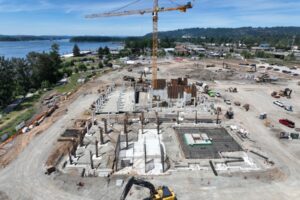Roy Kim wants the Waterfront at Parker’s Landing mixed-use urban center to provide visitors with “a sense of place” when it opens in 2024, and believes that the first phase of construction will allow the development to deliver on that promise.
During the Port of Camas-Washougal’s Feb. 3 commission meeting, Kim, the owner of Portland-based RKm Development, presented his latest vision for the general layout of the first phase of construction, scheduled to begin in fall 2022.





